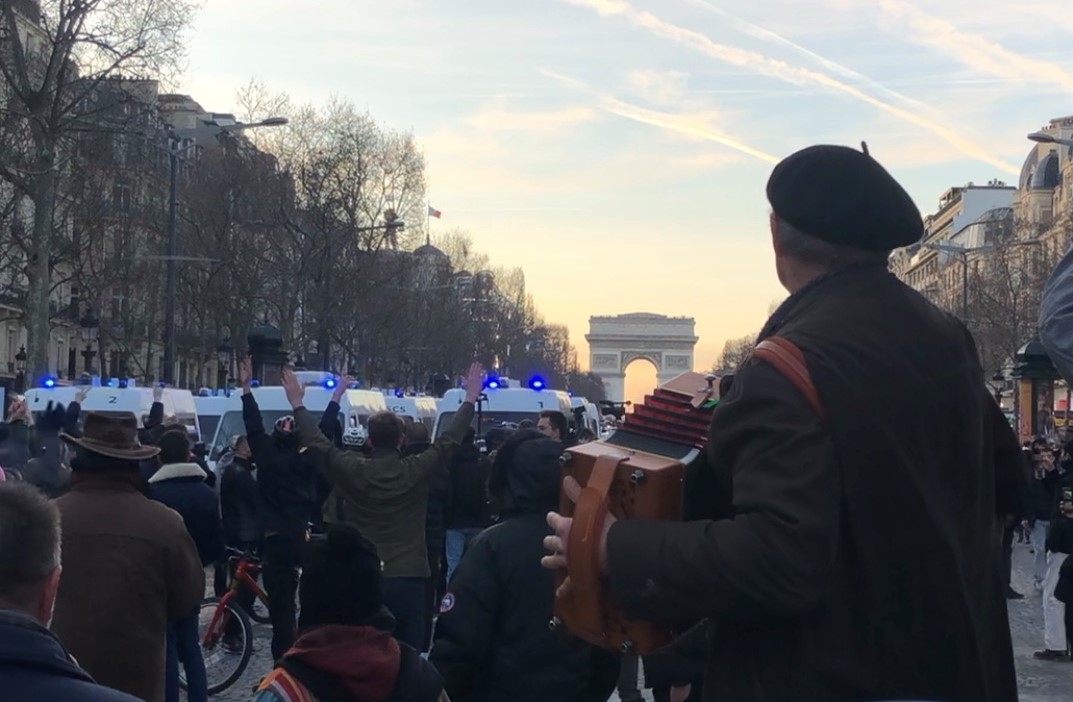Teargas & Truncheons: Experiencing Pandemic Protests in Paris

The proudest boulevard in France, the Champs-Elysée, was humbled into chaos in early February as Paris’s ongoing Ottawa-style, ‘Convoi de la Liberté’ or ‘Freedom Convoy,’ hit the French capital.
*Please note, this article was written directly after the protest and, as such, some parts will reflect this.*
I went to Saturday’s protest to observe and experience what I’d been following so closely online and even before my arrival to the thoroughfare, I was presented with a warning. A man passed me on a motorbike on his way to the demonstration waving a French flag and I watched with considerable alarm as it was very forcefully and recklessly snatched from his hands by a French police officer, causing the man to swerve dangerously.
In Britain, the use of chemical weaponry is still unusual. Not so in France…
The side roads soon became blocked by demonstrators, but so far as I could see the protest was peaceful. I had by that time, accessed the middle of the road and to my dread the police were bent on dispersing any crowds there by force. In Britain, the use of chemical weaponry is still unusual. Not so in France. First used by the French themselves in August 1914 during wartime, the worrying promotion of tear gas from a wartime accoutrement to a domestic police tool seems to have gone surprisingly undisputed.

The ready recourse to tear gas on this occasion was shocking and relentless, against young and old alike. I ended up being in the firing zone at a few points and as it rained down us, I must say if you haven’t experienced it before, the sensation that your eyes and lungs are burning is quite bewildering. The fierce police charges were equally as uncompromising. It was aimed at the those who were walking and gathering in small groups on the Champs-Élysées. The police were hostile and aggressive, waving shields and batons, and the hounding of those who loitered continued into the night. President Emmanuel Macron had ‘urged calm’ but it was the brutish behaviour of certain police officers that seemed to constitute the greatest threat to public order. The following day, the Paris police prefect opened an internal investigation into police conduct after a video was circulated online of a police officer apprehending a vehicle, believed to be part of the convoy on Place de L’Étoile, and pointing a weapon at the driver.
A conglomeration of the left, the right, the gilets jaunes, the anti-vaxxers and the anti-pass campaigners joined together in a powerful show of hostility to the continuing use of mandatory vaccine passports. Unlike in Britain, where the imminent removal of all coronavirus restrictions was recently announced, up until March 14th, in France a vaccine passport is required for access to all public attractions as well as entertainment and hospitality venues.

The authorities had ample warning of the planned protest, partly through a Facebook group that drew in almost 350,000 followers in its first few days. The French police stationed themselves extensively around the city centre with over 7,000 police officers deployed. French police stated that their enormous escalation was necessary due to the risk that the protestors posed to ‘public order’. They issued a ‘stay-away order’ prohibiting truck convoys entering Paris, and indeed succeeded in stopping almost 500 of them – especially those from the South of France who had rallied to the cause. However, despite their best efforts, many streets in the centre were at times very effectively gridlocked by the use of vehicles and supportive crowds of protestors. There has been much dispute about these emergency measures and the response of the police authorities.
I got the distinct impression that this much larger than usual protest was being driven by more than the demand for the removal of vaccine passports
A noticeable aspect was the lack of a leading figure or any unified leading force. Talking to many demonstrators, I got the distinct impression that this much larger than usual protest was being driven by more than the demand for the removal of vaccine passports – a demand, after all, that has manifested itself every Saturday in Paris recently in the form of sizeable marches through the city. A much deeper dissatisfaction with the government and the authorities seems to be developing, but without a strong focus. However, one resounding cry did come through – Liberté!
Edited by Ryan Gerrett


